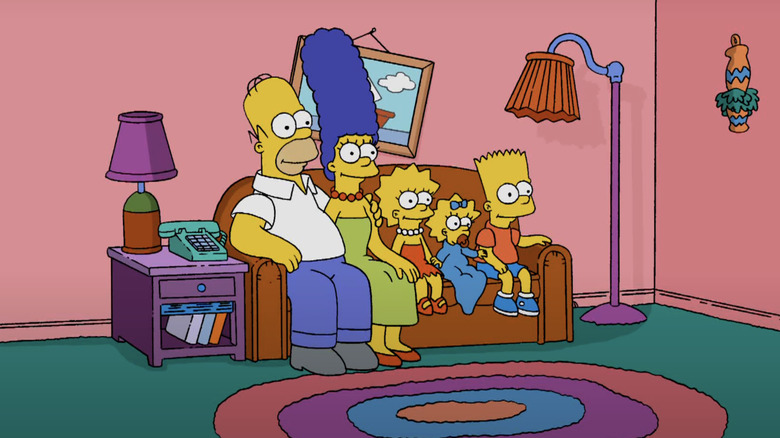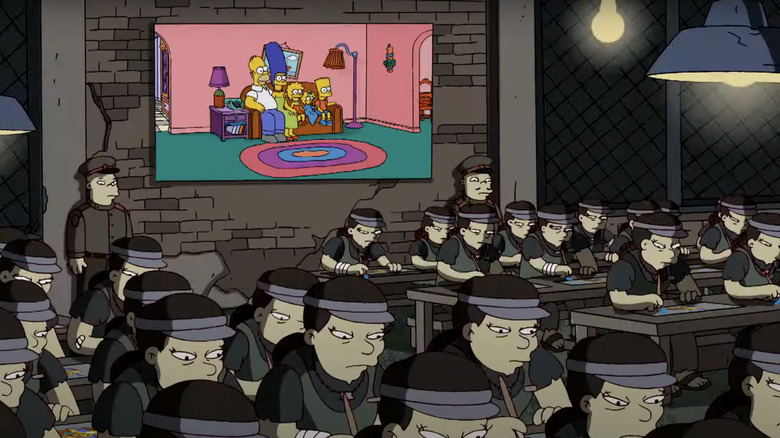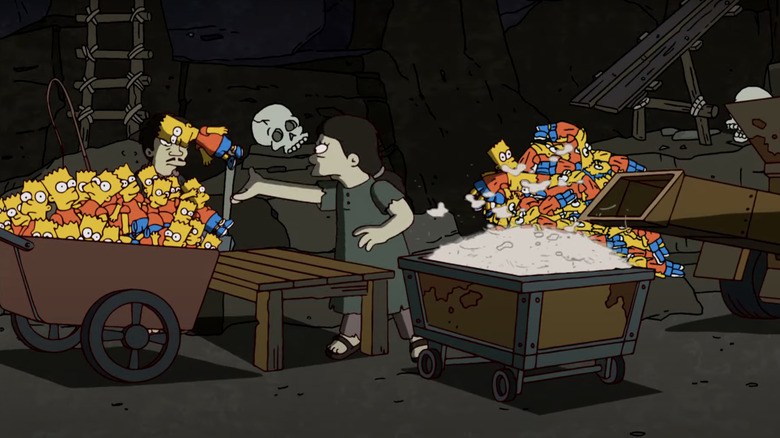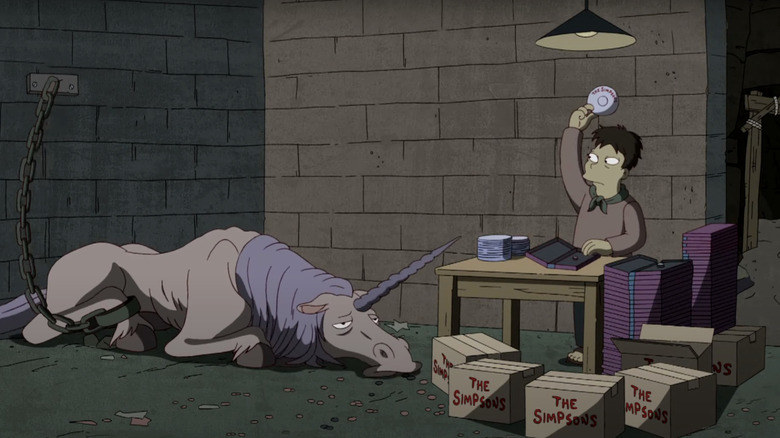The Simpsons' Most Controversial Couch Gag Involved A Notorious Artist
Back in season 4 of "The Simpsons" Bart watches an episode of "Eye on Springfield" wherein Kent Brockman stands in a sparse warehouse in Korea to give viewers a "first-hand look at how American cartoons are made." As rows of harried animators furiously scribble on paper they're prodded by rifle-toting soldiers in a brief gag that saw the show's writers taking a jab at themselves and American networks outsourcing animation to countries where labor was much cheaper than in the U.S.
Since the very first episode of "The Simpsons" in 1989 — which was almost very different — the show has been at least partly animated in South Korea, with animator Nelson Shin's Akom studios being the most prominent example of a Korean studio contributing to the show's creation. The company has, to date, animated more than 200 episodes of the long-running series, and was surely part of the inspiration behind the "Eye on Springfield" segment. But the soldiers jabbing at sleep-deprived animators was clearly an exaggeration, designed to call out the far less severe yet still problematic practice of using cheap foreign labor to provide American audiences with their entertainment.
This depiction of a Korean sweatshop appeared in the episode "Itchy & Scratchy: The Movie," which first aired in 1992. 18 years later, "The Simpsons" essentially redid the same gag, but this time it was a lot less funny, a whole lot longer, darker, and much more controversial.
Banksy took The Simpsons couch gag to a dark place
The best couch gags on "The Simpsons" are fondly remembered by a generation who grew up with the show. Now that the series has been running for a full 36 seasons, however, this running joke has been mostly dropped from the opening sequence — though the occasional couch gag still pops up from time to time. It's not hard to see why these little vignettes were discarded. After a while it must have become impossible to think up new ideas.
In fact, judging by some of the examples we saw in more modern "Simpsons" episodes, it's arguably a good thing that the show isn't allowed to sully the sacred couch gag any more. Take the "gag" included at the beginning of season 22's "MoneyBart." The 2010 episode featured an opening sequence orchestrated by secretive British street artist Banksy, whose name can be seen scrawled on a billboard during the title sequence of the episode. When we get to the couch gag, however, we're confronted with a nightmarish depiction of a dungeon in which lines of gray, beleaguered Asian animators are seen drawing "Simpsons" cells.
Banksy's take on the couch gag gets off to a disappointing start by essentially recreating a joke from 18 years prior, but then things just get downright disturbing, as the camera tracks through the underground cavern to reveal rats carrying human bones, a worker throwing cute kittens into a grinder to be used as stuffing for Bart Simpson dolls, and a malnourished unicorn's horn being used to poke holes in "Simpsons" DVDs. At the end, we see a 20th Century Fox logo rising from slums surrounded by a barbed wire fence. As The New York Times commented following the episode's airing, the "running joke went to a very dark place."
Perhaps unsurprisingly, this particular couch gag proved quite controversial, and not necessarily for the reasons you might expect.
Banksy's couch gag caused upset abroad
In the early years of "The Simpsons," the show frequently courted controversy from right-wing groups for what they saw as a crude depiction of the American family and a subversion of classic American ideals — perhaps that's partly the reason why "The Simpsons" has never managed to get a U.S. President as a guest. As such, had Banksy's grim couch gag aired back in the day, it probably would have stoked the ire of conservatives. In 2010, however, it actually upset the Koreans more than anybody else.
As Time reported it was Nelson Shin and his workers in Korea that actually objected to what appeared to be Banksy calling attention to oppressive employment of underpaid foreign workers. Shin and his staff protested at the ominous depiction of working conditions in the sequence, with Time noting that Akom company workers actually animate much of the "The Simpsons" in "high-tech workshops in downtown Seoul." As Shin put it, "Most of the content was about degrading people from Korea, China, Mexico and Vietnam. If Banksy wants to criticize these things ... I suggest that he learn more about it first."
I'm not sure the sequence was intended to degrade foreign workers, and was much more an attempt by Banksy to call out 20th Century Fox (which was later acquired by Disney). Either way, as Time noted in its report, Korean workers actually did make about one-third of their American counterparts' salaries, even while their wages are high relative to their own country. It's hardly the doom-laden vignette of the couch gag, but this was clearly the intended target of the sequence. Still, Korean animators clearly didn't see it that way.
There wasn't much gag in Banksy's couch gag
A behind-the-scenes documentary from 1999 actually features Nelson Shin and some of his team members, providing a glimpse at the office in which the Akom staff worked. It hardly resembles the dungeon depicted in Banksy's extended couch gag, though at one point we see the main floor of the studio where workers painted an average of 100 cells a day and worked from 10 am to 6.30 pm (still no soldiers in sight, though). In the clip, Shin also acknowledges that Hollywood turned to Korean animators in the 1980s "because of the high wage problems in Hollywood at that time," which is partly what Banksy was highlighting with his gloomy vignette.
But while his depiction of a dungeon full of enslaved drones might well have been aiming for humor through exaggeration, the artist is also known for his defiant anti-capitalist, anti-corporate style, which doesn't exactly make for the most hilarious "gag." Banksy has often been described as using "dark humor" in his work to highlight societal issues, but there are those who don't really find much funny about his work. As Mof Gimmers at HecklerSpray put it following the episode's airing, "He's the art-world's Bono, constantly asking us to look at ourselves like we're brain-dead scum."
All of which is to say that it was sort of funny and subversive for "The Simpsons" to poke fun at its own network for using cheap labor in season 4, but 18 years later the "dark humor" of Banksy's extended nightmare vision just didn't really land, and as the couch gag goes on and on hard to tell what exactly what the purpose of it all is — especially when you have Korean animators essentially saying "er, actually we're all good."
As Time notes, the bleak sweatshop of Banksy's couch gag actually calls to mind North Korea where, "in the capital of Pyongyang, a state-run animation studio, SEK Studio, has been grinding away at many European and Chinese cartoons since 1997." SEK reportedly worked on "The Simpsons Movie," but doesn't appear to be a regular contributor to episodes. Still, it can't be said that Banksy's contribution to "The Simpsons" didn't prompt discussion, and in that sense he probably accomplished what he set out to do, while simultaneously making the case for abolishing couch gags altogether. As such, he's probably not going to be remembered as one of the best guests to ever contribute to "The Simpsons."



